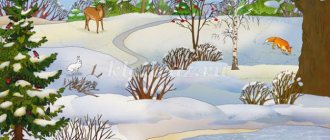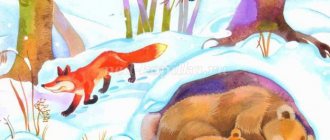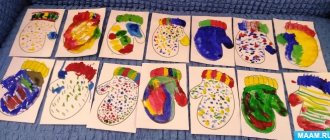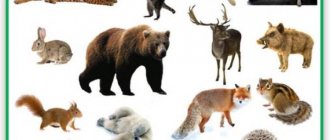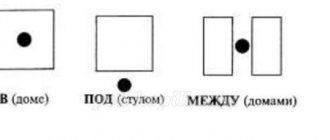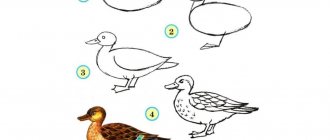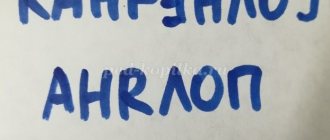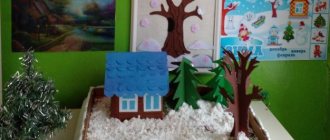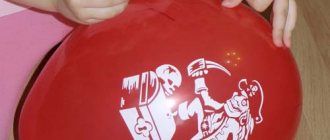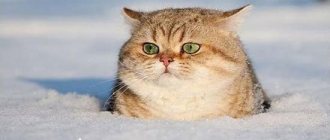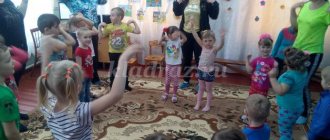LiveInternetLiveInternet
Quote from Tatyana57
Read in full In your quotation book or community!
SPEECH DEVELOPMENT. LEXICAL TOPIC “WILD BEASTS OF OUR FORESTS AND THEIR CHILDREN”
CHILDREN SHOULD KNOW THE NOUNS: bear, she-bear, bear cub, wolf, she-wolf, cub, hare, hare, little hare, fox, fox, fox, fox, hole, lair, squirrel, squirrel, hollow, moose, elk, calf, horns, hedgehog , hedgehog, hedgehog, wild boar, female boar, boar, badger, badger, little badger, forest, clearing, cheat, paw, wool, claws, nose, ears, hooves, tail. Muzzle, snout, mouth, animals, cubs, bushes, trees, mouse, lynx, raccoon, beaver, deer, marten, fangs, sable, mink, mole, den, connecting rod. ADJECTIVES: brown, clubfooted, cunning, predatory, gray, tireless, scary, thick (fur), red, wild, fluffy, dexterous, careful, fast, white, cowardly, long-eared, lop-eared, sensitive (ears), oblique, timid, velvet, prickly, wolf, striped. VERBS: wanders, climbs, roars, tears (bast), jumps, gallops, growls, grins. Hunts, escapes, howls, gnaws, digs, runs, “gave a go,” collects, stores, grunts, sniffs, sniffs, listens, hides, pricks, sneaks, sucks, lies down, falls. CHILDREN SHOULD BE ABLE TO NAME THE FAMILY: Bear, she-bear, little bear. Hare, hare, little bunny... SELECT NOUNS TO ADJECTIVES: Brown, club-footed, clumsy -... Gray, toothy, scary -... Cunning, fluffy, red-haired -... CALL MOM: The bear's cub, the fox's cub..., the bunny's... WHO HAS A VOICE : The fox yelps, the bear growls, the wolf howls... WHO LIVES WHERE: A fox lives in a hole. In the den - ... In the den - ... In the hollow - ... TO WHOM WE WILL GIVE WHAT: Meat - to the wolf, raspberries - ..., honey - ..., carrots - ..., nuts - ... SELECT NOUNS TO THE VERB: Hunts - ... Sneaks - ... Howls - ... Bites - ... Jumps - ... Tricks - ... Waddles - ... SELECT SIGNS: Wolf (which one?) -.... Fox (what?) - ... Hedgehog (what?) - ... SELECT ACTIONS: Bear (what is he doing?) - ... Fox (what is he doing?) - ... Hare (what is he doing?) - ... CORRECTLY ANSWERING THE QUESTIONS: Whose? WHOSE? WHOSE? WHOSE? Track - wolf, fox, hare... Ears - bear, hare, squirrel... Head - elk, hedgehog, wolf, fox... FORM NEW WORDS USING PRESIDENTS: Walks - moves, leaves, goes around, passes, enters, enters, descends, finds , leaves, approaches, reaches, comes, leaves, passes. COMPLETE A DESCRIPTIVE STORY ACCORDING TO PLAN. What is the name of? Where does he live? What kind of home does he have? What is the appearance? What habits? What does it eat? How does it get food? What are his enemies? How to defend yourself? What is the cub's name?
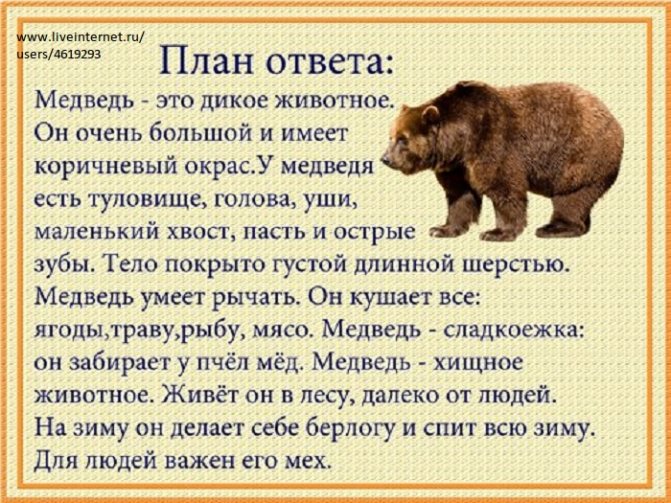
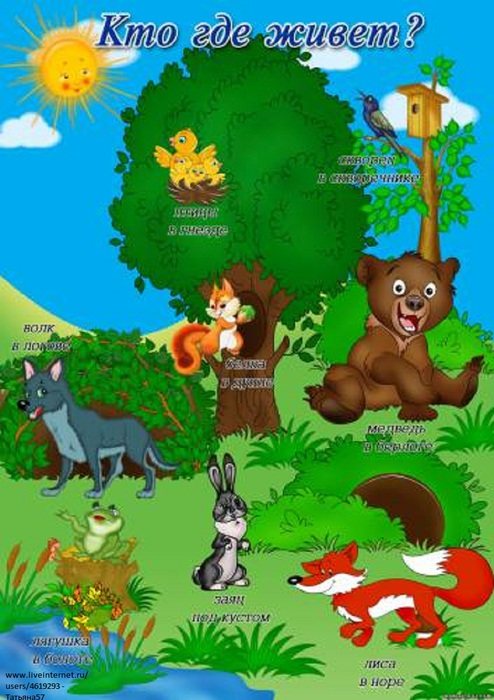
The fox is a predator. The fox mainly hunts mice, gophers, and less often hares. The fox cunningly catches hedgehogs. She rolls the hedgehog to the water, he straightens his spines in the water and swims to the shore. This is where the fox is waiting for him. The fox lives in a hole, and in the spring the fox gives birth to cubs. The squirrel is a rodent. She eats nuts, berries, mushrooms, and pine cones. The squirrel has sharp claws. This helps her quickly climb the tree. The fluffy tail serves as a parachute for the squirrel. A squirrel lives in a hollow and insulates its nest with down. In summer the squirrel is red, and in winter it is gray. In winter, the squirrel sleeps almost all the time and rarely looks out of the hollow. The squirrel is a thrifty housewife. She prepares nuts for the winter and dries mushrooms on tree branches. In the spring, squirrels give birth to squirrels. The wolf is a predatory animal. Wolves live in a pack. A pack is a wolf family. Wolves almost always hunt for sick, weak animals. Wolves hunt at night. Wolves live in a den to raise wolf cubs; wolf cubs appear in the spring. The bear is an omnivore. He loves to eat honey, berries, fish, ants, roots, but can also attack humans. The bear is clumsy in appearance, but easily climbs trees and runs quickly. The bear builds a den for himself from twigs, fallen trees, and moss. In winter, a mother bear gives birth to cubs. If a bear has accumulated little fat since the fall, it wakes up in the winter and walks through the forest hungry. For this the bear was nicknamed the connecting rod. The hare is a rodent. The hare feeds on grass, leaves, shrub bark, mushrooms, and roots. In winter, it chews the bark of trees. The hare is white in winter and gray in summer. This helps him hide from predators. Long, fast legs also save the hare from its enemies. The hare runs up the mountain at a run, and down the mountain somersaults. The hare lives under a bush in the summer, and digs a hole in the snow in the winter. In the spring, the hare gives birth to baby hares.
EXERCISE “GUESS AND TELL”. This beast lives in the forest, gnaws the bark of the trunks. In the summer in a gray fur coat, and in the winter in a white one. (Hare) - What does the hare eat in the spring? (grass, leaves). The owner of the forest wakes up in the spring, and in winter, to the howl of a blizzard, he sleeps in a snowy hut. (Bear) -What does a bear eat? (roots, grass, beetles, mice, hares). You and I recognize the animal by these two signs: He wears a gray fur coat in the winter, and a red fur coat in the summer. (Squirrel) - What does a squirrel feed on? (cones, nuts). All winter between the Christmas trees I slept through a bag of needles. “F-f-f-f—stop sleeping, It’s time to get up!” (Hedgehog) - What does a hedgehog eat? (bugs, worms, mice). Gray and toothy. Howls on a rainy day: “Uh-uh...” (Wolf) - What food does a wolf eat? (meat - catches mice, hares, sheep). Fluffy tail, golden fur, lives in the forest, steals chickens in the village. (Fox) - Who else does the fox catch? (mice, hares).
Exercise 1.Parents are recommended:
- look with your child at illustrations depicting animals of our forests - a hare, a squirrel, a wolf, a bear, a hedgehog and a fox; note their external signs;
- talk about where they live, what they eat; consolidate the names of animals and their cubs in the child’s vocabulary;
- visit the zoo as an excursion.
Task 2.
Solve riddles (learn by choice).
I confess, I am guilty: I am cunning and cunning. I often sneak into the chicken coop in the evening. (Fox)
Under the pines and under the fir trees there lives a ball of needles. (Hedgehog)
A fast little animal hops and hops through the trees. (Squirrel)
Gray flannelette animal, cross-eyed long-eared.
Well, guess who he is, and give him a carrot. (Hare)
Who walks around angry and hungry in the cold winter? (Wolf)
In summer he walks through the forest, in winter he rests in a den. (Bear)
Task 3.
Didactic game “Guess who it is?” (match nouns to adjectives).
Brown, club-footed, clumsy - ... .
Gray, toothy, scary -….
Sly, fluffy, red - ....
Small, long-eared, timid -...
Gray - ..., clubfoot - ..., cunning - ..., prickly - ... .
Task 4.
Didactic game “Who has who?” (word formation exercise): for a bear - a bear cub, for a wolf - ..., for a fox - ...; a bear has cubs, a wolf has ....
Task 5.
Didactic game “Name the family” (word formation exercise): dad is a bear, mom is a bear, cub(s) is a bear cub(s); dad is a wolf..., dad is a hare -...; dad is a hedgehog...; dad is a fox...
Task 6.
Didactic game “Name Mom” (use of the genitive case of nouns): a bear cub for a bear, a little fox for ....
Task 7.
Didactic game “Who gives what voice?” (match the verb to the noun): fox - yelps, bear - growls, wolf - howls, squirrel - ....
Task 8.
Didactic game “Who can you say about ...” (match a noun to the verb): hunts - ..., sneaks _ ... howls - ..., bites - ..., gets scared - ..., jumps - ..., waddles - ..., cunning - ..., tracks - ... .
Task 9.
Didactic game “Who lives where?” (use of the nominative case of nouns).
Living in the hole (who?) is a fox.
In the den - ....
In the hollow -….
Task 10.
Didactic game “Who will we give what?” (use of dative case of nouns).
Meat - to the wolf, raspberries - ..., honey - ..., carrots - ..., apples - ..., nuts - ..., mushrooms - ....
Task 11.
Didactic game “Hunter” (use of the genitive case of nouns). The hunter caught (who?) in the forest - ....
Task 12.
Exercise for coordinating speech and movements.
I'm like a squirrel in a wheel, jumping on the spot,
To make it more fun, let's gallop together.
One, two, three, four, five - the little bunny began to jump.
The little gray one is good at jumping - he jumped ten times.
| The child jumps in place. The child jumps 5 times to count. After the words “he jumped ten times,” the child jumps 10 times. |
Task 13.
Exercises for fingers.
Bunny
| The gray bunny jumps deftly. He has a carrot in his paws. | Lean your elbow on the table, spread your index and middle fingers to the sides, and clench the rest into a fist. |
Bunny and ears
| The bunny's ears are long and stick out from the bushes. He jumps and gallops, making his bunnies happy. | Fingers in fist. Point your index and middle fingers up. Move them to the sides and forward. |
Task 14.
Compose a descriptive story about a wild animal in our forest (optional) according to plan:
Name.
Where does he live?
Housing.
Appearance.
What does it eat?
Cubs.
Task 15.
Cut out pictures of animals from our forests and paste them into an album.
Wild animals of the forest
Hare
The hare lives in the forest. He does not dig holes for himself, but hides in bushes, in recesses under roots, under branches, where he builds a winter hut for himself. The hare's main food is grass, hay, and young tree branches. The hare also eats vegetables, fruits and berries, if he can find them.
Fox
The fox is a wild animal. She lives in the forest, in a hole. The fox is a predatory animal. The main food of foxes is insects (beetles, earthworms) and small rodents (voles). If the fox manages to catch a hare or a bird, which does not happen very often, she will happily eat them too. Often foxes settle next to humans and steal poultry from poultry houses. Sometimes she can also feast on fish washed up on the shore. She will not disdain berries and fruits when she is hungry.
Wolf
The wolf is an animal of the forest. Wolves live in a den. Wolves hunt in packs, so they are able to catch large prey: elk, deer. The wolf will gladly treat himself to both the bird and the bunny. In hungry years, wolves can attack livestock, but this happens very rarely. Wolves are very cautious and afraid of humans.
Hedgehog
Hedgehogs live in the forest. They rarely dig holes themselves, more often they occupy someone else’s or build a nest among protruding roots, under a bush, in depressions in the ground, dragging there a lot of leaves, dry grass and moss. In winter, hedgehogs hibernate. Hedgehogs eat mainly insects. If they come across a snake, they might eat it too. Don't mind eating mushrooms, acorns, berries and fruits.
Brown bear
The brown bear is a wild animal of the forest. For the winter, the bear builds a den for itself and hibernates. The main food of bears is berries, roots, and mushrooms. If a bear finds a bird's nest, it will feast on eggs; if it finds a hive of wild bees, it will eat honey. The bear knows how to catch fish and eats it with pleasure. He can even eat a mouse if he manages to catch it. He will not disdain carrion either.
Squirrel
A squirrel lives in the forest. She finds a hollow in a tree and settles there. The squirrel eats berries, fruits, mushrooms, nuts, acorns and grains. Stores supplies for the winter, hiding them under roots or among tree branches so as not to starve in winter.
Desert Animals
Camel
Camels live in desert and semi-desert. They don't build housing. They feed on grass (both dry and fresh), tree branches, camel thorn, ephedra, wormwood, and chew saxaul branches. A camel accumulates nutrients in its humps, so it can go without food for a long time.
fennec
Fenech lives in deserts and semi-deserts. He digs himself a hole in the sand. Fennec fox is omnivorous. It feeds on insects, lizards, bird eggs, small rodents, and plant roots that can be dug up in the desert.
When the child has become acquainted with animals, their way of life, and nutrition, let him try to tell himself about what he remembers. Pictures and diagrams with an algorithm for composing a descriptive story will help with this >>
At first, you may not be able to get a coherent story, then try printing and cutting the cards above into sectors, and ask your child to arrange the pictures correctly.
More detailed stories for children about animals can be found on our website in the sections:
We enrich and activate our vocabulary. We consolidate knowledge of nouns:
squirrel, hollow, fox, hole, hedgehog, hare, wolf, lair, elk, bear, den, lynx, forest, deer, horns, hooves, body, fangs, wool, fur, needles, skin, mouth, paws, belly, claws;
verbs:
extract, jump, scour, howl, growl, squeak, roar, hunt, hide, yelp, snort, teach, guard, suck, loop, feast;
adjectives:
large, small, shaggy, shaggy, fluffy, strong, cunning, prickly, fast, dexterous, brown, toothy, clumsy, clumsy, beautiful, sharp, striped, powerful, flexible, clumsy, cautious, predatory;
adverbs:
quickly, deftly, slowly, dangerously, scary.
We teach a child to write riddles and descriptions about wild animals
. The first words in the riddle must be the words: this is an animal. The next words may be to clarify the size of the animal (large, small, small, etc.). Then you need to talk about the characteristic features of appearance (fluffy, shaggy, prickly, clumsy) and what the animal eats.
Summary of an open speech therapy lesson on coherent speech on the topic “Wild animals of our forests”
Goal: To clarify and systematize students’ knowledge on the lexical topic “Wild animals of our forests.”
Tasks
Educational:
- activation and enrichment of vocabulary on the lexical topic “Wild animals of our forests”
- practice forming complex adjectives
- teach to name words-signs
Educational:
- develop the ability to listen carefully to the teacher and peers
- cultivate respect for nature
- develop interest in the content of the lesson
- education of hard work
Corrective:
- correction of agrammatic phrase construction
- overcoming speech negativism
- development of articulation (improving the mobility of the organs of the articulatory apparatus)
- development of speech breathing
- development of fine motor skills
- development of spatial concepts
- development of coherent speech skills
- development of children's thinking based on descriptive riddles
Progress of the lesson:
Organizing time.
- Hello guys. Today in class we will have to complete many different tasks. To successfully cope with them, we need to be properly prepared.
Therefore, we listen to me carefully and work diligently.
- Let's repeat the rules that we use in speech development classes.
- Speak slowly, without rushing. Pronounce all sounds clearly.
Breathing exercises
- Guys, now we will sing the vowel sounds: A, O, U, I
Remember that we inhale through the nose, exhale through the mouth
Speech gymnastics
Pure talk
Su-su-su - we saw a fox Zha-zha-zha - the hedgehog has needles. La-la-la - a squirrel lived in the forest. Xia-xia-xia - we saw a moose in the thicket. Olk-olk-olk - a wolf spends the winter in the den. Sy-sy-sy - the bunny jumps from the fox. After all, after all, after all, the bear sleeps in winter
Lesson topic message
- Guys, now look at the board and tell me which animal is the odd one out? (The cow is extra.)
- Why? (Because all animals are wild, but a cow is a domestic animal.)
- Well done.
— You probably already guessed who we’ll talk about in class today? (Yes. About wild animals.)
— That's right, about wild animals.
- Why are they called wild? (Because they live in the forest).
- What is another name for animals? (Beasts)
Work on a lexical topic
- Guys, let's name the cubs of these animals. I throw the ball and name the animal. You name the baby animal and throw the ball back to me. Who's the squirrel's baby? The hare? The fox? The wolf? The bear? At the moose? The hedgehog? I open the pictures on the board and check with the children’s answers - Guys, let’s now draw wild animals and describe them. What are they? - Bear (what?) Brown, huge, shaggy, clubfooted, clumsy, strong. - Hare (what?) Small, nimble, white, long-eared, fluffy. - Fox (what?) Sly, red-haired, - Hedgehog (what?) Prickly, small - Squirrel (what?) Agile, fluffy, flickering
In the next task you need to complete sentences and say words with the opposite meaning.
The elk is big, and the hare... (what?) is small. The squirrel is weak, and the wolf... (what?) is strong. The wolf has a long tail, and the bear has... (what?) is short. The fox is a predatory animal, and the hare... (what?) is a herbivore.
Now guys look at the picture and name whose tail is. - Whose tail does the hare have? (hare) - Whose tail does the fox have? (fox) - Whose tail does the wolf have? (wolf)
Finger gymnastics “Squirrel sitting on a cart”
A squirrel sits on a cart. (Clenching and unclenching the fingers of both hands) She sells nuts: (Make a circle with the index finger and thumb) To the mustachioed bunny, (Finger exercise “Hare”) To the thick-fifted bear, (Knock on the table with the edge of the palm) To the gray wolf cub, (Finger exercise “Wolf”) To the prickly hedgehog. (Finger exercise “Hedgehog”)
Working on difficult words
- Now let’s name some difficult words. A hare has long ears - long-eared. A hedgehog has a sharp nose - pointed-nosed. A hare has slanted eyes - cross-eyed. A bear has a short tail - short-tailed.
Orientation in space
- Guys, repeat after me. Left and right build cities, Left and right drive trains, Left and right know how to sew and darn, Left and right know how to clap loudly.
Raised your left hand, raised your right hand. The eyes looked up and down. We touched our left ear with our right hand and covered our right eye with our left hand. We touched our right ear with our left hand and covered our left eye with our right hand.
Arrange the animals in relation to the tree: squirrel on the right, hare on the left, bear at the top, wolf at the bottom.
Compiling a story-description
- Guys, now let's tell you where wild animals live? Where does the squirrel live? (The squirrel lives in a hollow) Where does the fox live? (The fox lives in a hole) Where does the hare live? (The hare lives under a bush) Where does the wolf live? (The wolf lives in a den) Where does the bear live? (The bear lives in a den) Where does the hedgehog live? (The hedgehog lives under the leaves) Where does the moose live? (The moose lives in the forest)
- Guys, now we will try to compose a short description story about animals. For example, let's make a story about a squirrel. Where does the squirrel live? The squirrel lives in a hollow. What does a squirrel eat? The squirrel eats nuts and mushrooms. So is the squirrel a carnivore or a herbivore? Herbivore Name the baby squirrels? Baby squirrels. What does a squirrel look like? The squirrel has red fur, small paws, a long fluffy tail, and tassels on its ears.
- Now I will give you cards with animals, and you will write your own description story. The speech therapist hands out cards with animals (bear, fox, hare, wolf, hedgehog) And now, in turn, everyone describes their animal. -Okay, well done.
-Guys, now guess the riddles about wild animals
Puzzles
Not a lamb or a cat, wears a fur coat all year round. A gray fur coat for summer, a different color for winter. (Hare)
A lush tail sticks out from the top, What is this strange little animal? Well, of course, this is... (Squirrel).
Cunning cheat, Red head. A fluffy tail is a beauty. Who is this? (Fox)
In a dense forest under a fir tree, showered with leaves, lies a bag of needles, prickly and alive. (Hedgehog)
Who walks around angry and hungry in the cold winter? (Wolf)
The owner of the forest wakes up in the spring, and in winter, to the howl of a blizzard, he sleeps in a snowy hut. (Bear)
Summary of the lesson (reflection)
Guys, tell me what animals we studied in class today? That's right, wild animals. Why are they called wild? Okay, well done. So our lesson with you has come to an end. Did you guys like it?
Gorevaya Olga Andreevna teacher-speech therapist, MKDOU No. 335 combined type, Novosibirsk
